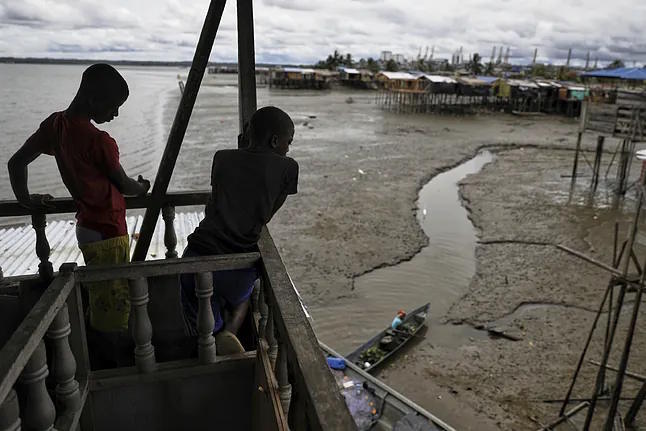While in Chile, where the maximum tsunami alert was still active, they evacuated five women's prisons in coastal regions such as Valparaíso, transferring the inmates to inland penitentiary centers, the residents and tourists of Easter Island and the Galapagos Islands waited on elevated ground because they continued to receive alerts of the possible arrival of large waves.
These scenes are from the early morning hours, but we also saw them throughout Wednesday in many corners of the Pacific, from Japan to the west coast of the United States.An earthquake and its subsequent tsunami kept more than twenty countries on edge, but the waves were not as destructive as feared, and early warnings worked better than ever. Millions of evacuees have already returned home.
On Wednesday, a powerful magnitude 8.8 earthquake, one of the largest ever recorded, struck the coast of the Kamchatka Peninsula in Russia. Just ten minutes after the quake, the Pacific Tsunami Warning System, coordinated by UNESCO, issued an initial alert covering the highest-risk areas, particularly the Russian and Japanese coasts. Twenty minutes later, the alert for the possibility of colossal oceanic waves was relayed by national centers along the Pacific coast, immediately activating evacuation protocols.
The initial scare and uncertainty - except in Japan, where they are accustomed to orderly sheltering in safe places - dissipated as the hours passed, the feared large waves did not appear, and meteorological centers reduced or lifted the alerts.
In the remote and sparsely populated Kamchatka, the epicenter of the earthquake, residents of a port city, Severo-Kurilsk, were also quickly evacuated, which ended up flooded. In the Russian peninsula, dotted with volcanoes, some of which erupt every year, tremors are recorded periodically. The same happens in the neighboring Kuril Islands, an archipelago under Russian control but claimed by Japan, which calls them the Northern Territories, a sovereignty it lost after World War II.
Yelena Kotenko, a tour guide in the Kuril Islands, posted a video on her social media showing tourists in panic as they dodged tiles falling from a building's roof during the earthquake and then ran to take shelter on the slope of a volcano when the first waves of about one and a half meters arrived.
During Wednesday's early morning and Thursday morning, tsunami alerts remained in effect in some coastal areas of Chile, Ecuador, Peru, and Colombia. Also in some regions of Japan, the country closest to Kamchatka, and in small islands in the South Pacific such as Tuvalu and Vanuatu, where they are very concerned about rising sea levels.
Although no formal evacuation orders have been issued on these islands, the coastal population has been advised to remain on alert and ready to move quickly. Vanuatu's National Disaster Management Office has disseminated warning messages in the media and social networks to prevent people from approaching the coast.
A sea level rise of 50 centimeters would have devastating consequences for Tuvalu, an island nation with an average altitude of just over two meters. Much of its territory would be exposed to recurrent flooding, the intrusion of saltwater would contaminate underground aquifers, and access to clean water would be severely compromised. In addition, inhabited areas and farmland could become uninhabitable, forcing internal displacements or even migrations abroad.
In the Marquesas archipelago (French Polynesia), the first waves were observed on Nuku Hiva Island. According to the High Commissioner of the Republic in the region, Éric Spitz, the waves reached a maximum height of 1.5 meters, significantly lower than the initial estimate of up to four meters, although he recommended that the population continue to take precautions. He also stated that between five and ten new waves were expected after that initial impact. Although the alert was lifted in much of the territory, authorities maintain the recommendation to avoid low-lying areas and follow civil protection instructions. Marquesas Islands residents were able to return to their homes after confirming that the waves were less intense than expected.
In Samoa and Papua New Guinea, a moderate tsunami warning remains in place, which could generate dangerous currents and irregular waves during the day. Nautical activities are suspended, and fishing and maritime recreation areas have been temporarily closed. The Pacific Tsunami Warning Center has emphasized that, although the waves are not of great height, their unpredictable behavior can pose a considerable risk. In Fiji, a "tsunami watch" alert was declared, but it was later canceled as the direct threat had passed. However, the Fijian government issued a statement recommending that coastal communities remain vigilant against unusual marine currents and sudden sea level variations, even after the official alert is lifted.
Meanwhile, Australia and New Zealand maintain a cautious stance. The Australian Bureau of Meteorology reported that no destructive waves are expected, but anomalous sea movements are possible, so recommendations have been issued to stay away from port areas and beaches on the east coast. In New Zealand, the Ministry of Civil Defense has also urged caution on the north and east coasts of the country. Authorities in both countries are monitoring the sea's evolution in real-time through their sensor networks and have reiterated that "the threat has not completely passed."
In Hawaii, although an alert was initially activated and preventive evacuations were ordered in coastal areas, authorities ultimately ruled out the arrival of a large tsunami. Governor Josh Green confirmed that waves of up to 1.8 meters were recorded in Midway - an atoll nearly 2,000 km northwest of Honolulu - although ultimately no significant damage occurred. Minor waves were eventually recorded in Hawaii's coastal areas, with minimal damage reported and no injuries or prolonged evacuations.
